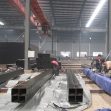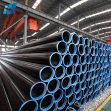How to produce seamless steel pipe in a mill?
Technically, steel pipes are long, hollow tubes that are used for a variety of purposes. They are produced by two distinct methods which result in either a welded or seamless pipe. In both methods, raw steel is first cast into a more workable starting form. It is then made into a pipe by stretching the steel out into a seamless tube or forcing the edges together and sealing them with a weld. As is known to all, the main advantage of seamless pipe is the elimination of seam-related defects. However, due to its higher cost of pipe manufacturing, the steel pipe price is relatively high by comparison with welded pipe.

Galvanized steel pipe generally has the rational cost effective in the market. Compared with other typical steel pipe coatings, such as specialized painting, powder coating, is much more labor-intensive, resulting in a higher initial cost for contractors. Besides, due to its durability and anti-corrosive properties, galvanized steel pipe can recycled and reused, which to some degree save a lot of money during the post maintenance work. Hot dipped galvanized pipe has been considered popular a lot among many users today. For one thing, the galvanization process protects the steel from rusting damage that can occur during transportation, installation and service. The zinc layer on the surface of pipe can form a barrier protection for steel products to extend the service life in applications. For the other thing, this layer is also resistant to wear and scratches, which makes the steel look more attractive.
Seamless pipe has been manufactured since the 1800’s. As a rule, according to the different production methods, seamless steel pipe has four major categories: hot rolled seamless pipe, cold rolled seamless pipe, cold drawn seamless pipe, extruded tubes. The production process for seamless pipe generally starts by steel pipe manufacturers from heating a metal billet temperature. The red hot billet is rotated and drawn by rolls over a piercing rod or mandrel. The action of the rolls causes the metal to flow over and about the mandrel to create a hollow pipe shell. The shell is then moved forward over a support bar and is hot rolled or cold rolled in several reducing/sizing stands to obtain the desired wall thickness and diameter. In addition, the hot-extrusion method involves working in the compressive-stress field. Therefore, it is characteristic of this method that high-alloy steel pipe of low deformability can be produced, as well as heavy-wall and large-diameter pipes.
Tel: +86 18202256900 Email: steel@fwssteel.com










